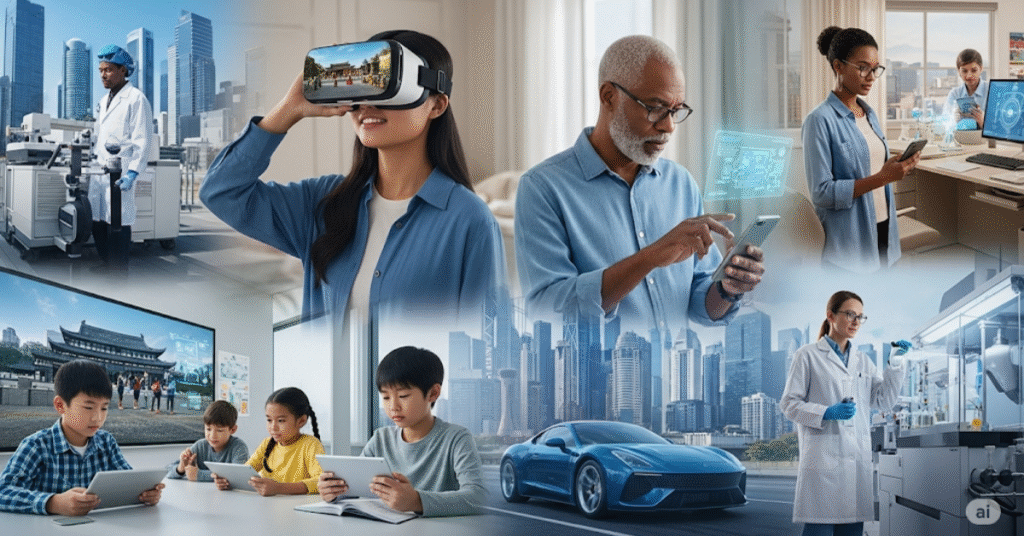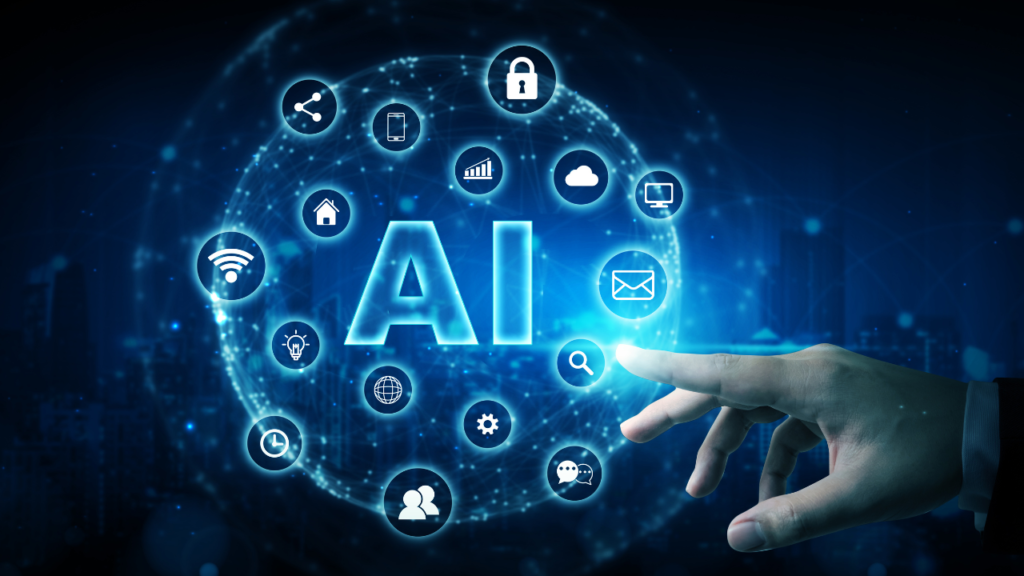Technology is no longer a luxury; it’s a daily necessity. In 2025, it shapes every moment of our lives. We wake up to smart alarms that adjust to our sleep patterns. Smartphones guide our schedules, while AI powers our emails, news, and entertainment. Smart homes manage lights, temperature, and even grocery shopping without us lifting a finger.
From communication to healthcare, transportation education, technology is everywhere. It’s in wearable fitness trackers, contactless payments, and virtual classrooms. These tools aren’t just helpful; they are essential.
This article explores how technology is transforming everyday life. You will see how it affects the way we live, work, learn, and relax. Using real examples and fresh data, we will explore how the digital shift is reshaping our habits, homes, and society.
The Rise of Smart Living
Smart Homes & IoT Devices
Smart homes are becoming the new standard in 2025. Virtual offices create a real-life feel.
They include breakout rooms for group work. Shared whiteboards help with collaboration. Real-time updates keep everyone in sync. Over 60% of homes globally have at least one IoT system installed.
Home Security & Remote Monitoring
Security is smarter and more accessible. Video doorbells from Ring and Arlo let homeowners monitor activity in real time. Smart locks from August and Yale allow keyless entry and remote access.
Motion detectors and AI-enabled surveillance can spot unusual activity instantly. These systems offer 24/7 peace of mind, whether you are home or away.
Technology in Communication
How Messaging & Video Calls Have Evolved
Communication in 2025 is faster, clearer, and more global. With 5G networks now covering over 70% of the world, video calls are nearly lag-free. Platforms like Zoom, WhatsApp, and Google Meet offer HD video, real-time screen sharing, and multi-user chats.
AI-based translation tools have broken language barriers. Apps like Google Translate and Skype Translator allow real-time speech and text translation during calls and messages. People can now chat across countries without needing a common language.
Seamless global communication is now the norm, whether for business meetings or family catch-ups.
Rise of Virtual Assistants in Daily Chats
Virtual assistants have entered our daily conversations. Siri, Alexa, and Google Assistant aren’t just voice-activated tools anymore; they are digital companions.
They manage calls, send texts, read messages aloud, and even respond with useful replies. In 2025, many people will use these assistants to schedule meetings, search the web, and control communication hands-free.
Health & Wellness Tech
Wearable Devices & Real-Time Health Monitoring
In 2025, wearable tech will play a major role in personal health. Smartwatches and fitness bands like Apple Watch, Fitbit, and Garmin track heart rate, sleep, steps, and oxygen levels in real time.
Advanced wearables now monitor blood pressure and glucose levels without invasive procedures. Devices like the FreeStyle Libre allow diabetics to track blood sugar continuously. Some smartwatches even detect irregular heart rhythms and alert users early.
These tools help users make better lifestyle choices and detect health issues before they become serious.
Telemedicine & AI Health Predictions
Telemedicine is now a core part of healthcare. Patients consult doctors through apps like Teladoc, MDLIVE, and Practomno; travel is not needed. Video calls, digital prescriptions, and follow-ups happen from home.
AI enhances care with early diagnosis. Systems analyse symptoms, records, and trends to suggest possible conditions. Platforms like Babylon and Ada use machine learning to provide health insights, helping doctors and patients make faster, more accurate decisions.
Work & Productivity
Remote Work & Virtual Offices
In 2025, remote work will be standard across many industries. Platforms like Zoom and Microsoft Teams enable daily virtual meetings. Virtual offices recreate real-life settings with breakout rooms, whiteboards, and live updates. Hybrid work blends home and office flexibility for a better balance. Tools such as Slack, Trello, and Google Workspace keep teams connected and organised. Employers now invest in digital infrastructure over physical space.
AI Tools Boosting Efficiency
AI has become a daily productivity partner. Tools like ChatGPT assist with writing, brainstorming, and coding. Grammarly improves clarity and tone in emails and documents. Notion AI organizes notes, manages tasks, and even summarizes meetings.
Automation tools handle repetitive work scheduling, email sorting, and data entry. Businesses save time, reduce errors, and focus more on strategy. In 2025, AI isn’t replacing workers—it’s helping them work smarter.
Shopping & E-Commerce Evolution
Personalized Online Shopping Experiences
Online shopping in 2025 is deeply personalized. AI tracks browsing habits and purchase history to recommend products that match user preferences. Sites like Amazon and Shopify use predictive algorithms to suggest what you need before you search for it.
Augmented Reality (AR) lets shoppers try on clothes, glasses, or makeup virtually. Brands like IKEA and Lenskart offer AR tools to preview furniture or eyewear in real-world settings.
Voice shopping is growing, too. Smart assistants like Alexa and Google Assistant allow users to order products just by speaking.
Quick Delivery & Smart Payments
Speed is now a key feature in e-commerce. Same-day delivery is common in major cities, thanks to improved logistics and micro-warehousing. Platforms like Instacart, Amazon Prime, and Foodpanda make fast service the norm.
Payments are smarter and faster. Digital wallets (Google Pay, Apple Pay), UPI, and QR codes offer one-tap checkout. Contactless transactions are safe, easy, and now widely accepted even at local shops.
Education & E-Learning
How Students Are Learning Differently in 2025
In 2025, learning is no longer limited to textbooks and classrooms. Students now use gamified apps like Duolingo, Khan Academy, and Quizlet to make studying fun and interactive. These platforms reward progress, track performance, and adapt to each learner’s pace.
AI tutors help with homework and test prep. Tools like ScribeSense and Socratic provide instant answers, explanations, and step-by-step solutions. Learning is now personalized, flexible, and available 24/7.
Role of VR & AR in Classrooms
Virtual Reality (VR) and Augmented Reality (AR) are transforming classrooms. VR lets students visit ancient cities, explore the human body, or conduct virtual science experiments—all from their desks.
AR adds interactive layers to textbooks and lessons. Apps like Google Expeditions and Merge EDU bring history, biology, and geography to life. In 2025, immersive tech is making education more engaging, visual, and memorable.
Transportation & Navigation
Self-Driving Cars & Smart Public Transport
In 2025, self-driving vehicles are no longer futuristic; they are real and on the road. Tesla’s Autopilot and Full Self-Driving systems can handle highways, traffic, and parking with minimal human input.
Cities are adopting AI-driven buses and trams that run on optimized schedules. These smart systems adjust routes based on passenger demand and traffic flow, reducing delays and fuel use.
Public transport apps now show live updates. They offer digital tickets. You can switch easily between buses, trains, and ride-shares.
Real-Time Navigation & Travel Planning
Navigation tools are smarter than ever. Google Maps and Waze use AI to analyze traffic, weather, and accidents in real time. They suggest the fastest routes and alert users to changes instantly.
Apps like Rome2Rio and Moovit combine flights, trains, buses, and walking paths into one simple travel plan. Travellers can now plan end-to-end journeys quickly with real-time accuracy.
Entertainment & Media
On-Demand Streaming & AI Recommendations
In 2025, entertainment is tailored to every user. Platforms like Netflix, YouTube, and Spotify use AI to suggest content. They analyze your preferences and past activity to personalize watch and listen lists.
Viewers no longer scroll endlessly. AI predicts what users want—before they ask. This boosts engagement and keeps content discovery seamless.
Streaming services now provide ultra-HD quality. They offer offline access for convenience. Multi-device syncing keeps viewing seamless. These features make on-demand media popular across all age groups
Rise of Virtual Reality in Gaming & Experiences
Virtual Reality (VR) has redefined how we play and interact. VR headsets like Meta Quest and PlayStation VR2 let users step inside games, creating lifelike, 360-degree environments.
But VR goes beyond gaming. Virtual concerts, art galleries, and travel experiences allow users to explore worlds from home. Platforms like Wave and VRChat host live events, letting fans connect in immersive spaces.
In 2025, entertainment is no longer passive; it’s fully interactive.
Daily Challenges of Tech Dependency
Screen Time Overload & Digital Fatigue
In 2025, excessive screen time is a growing concern. The average person now spends over 10 hours a day on digital devices. This constant exposure leads to eye strain, sleep disruption, and reduced attention spans.
Mental health is also affected. Studies link high screen usage with increased anxiety, depression, and social isolation, especially among teens and remote workers. Face-to-face interactions are declining, replaced by texts and video calls.
Digital fatigue is real. Many now seek screen breaks and tech detox routines to restore balance.
Privacy Concerns & Data Tracking
As tech use rises, so do privacy risks. Every click, voice command, and location is tracked. AI-driven platforms collect user data to serve personalized ads and content.
Surveillance cameras, facial recognition, and social media tracking have blurred the line between safety and intrusion. People are now more aware of their digital footprint, using VPNs, privacy browsers, and opting out of tracking.
In 2025, protecting personal data is as important as using technology itself.
What the Future Holds: 2030 & Beyond
The next wave of technology promises even deeper integration into daily life. Companies like Neuralink are making brain-computer tech.It may let people control devices with their thoughts. Companions will soon go beyond virtual assistants. They could give emotional support and manage routines. They may even chat like humans. Quantum computing is moving fast. It can solve hard problems in seconds. This could change medicine, climate science, and cybersecurity. By 2030, humans and machines will work even closer. This brings new chances and new risks.
Conclusion
Technology in 2025 has become inseparable from our daily lives. From the moment we wake up to the time we fall asleep, smart devices, AI tools, and digital systems shape our routines. They make life faster, more convenient, and often more productive. We shop with a voice command, work from anywhere, and monitor our health in real time.
But this convenience comes with challenges. Excessive screen time leads to mental fatigue. Our privacy is constantly at risk. Social interactions are becoming more digital than personal.
As we continue to embrace these tools, we must ask: are we still in control? Or are we slowly giving up too much in exchange for comfort? The future depends on how wisely we balance the benefits and the boundaries.
Are we using tech, or is tech using us?
FAQs
Q1: How is technology improving daily life in 2025?
Technology in 2025 streamlines daily tasks, boosts productivity, and enhances comfort. AI assistants and smart home devices help save time. They improve health tracking through real-time data. They also make communication smooth and instant.
Q2: What are examples of tech used every day?
Common examples include smartphones and smartwatches. Voice assistants like Alexa and Siri are widely used. Smart thermostats help control home temperatures. Online banking apps simplify financial tasks. Video conferencing tools connect people instantly. AI-based platforms recommend content based on your preferences.
Q3: Are smart homes safe?
Yes, most smart homes use encrypted connections and multi-factor authentication. Still, it’s important to update firmware often. Use strong passwords for all devices. Secure your home network to avoid hacking
Q4: Is AI replacing human decision-making?
AI supports decision-making by analysing data and suggesting options. It does not replace humans but enhances accuracy and efficiency. It does not replace humans but boosts accuracy and efficiency. This is especially true in healthcare, finance, and education.
Q5: How to reduce tech overuse?
Set limits on screen time. Take regular breaks from devices. Use focus apps to avoid distractions. Plan tech-free hours, especially before bed. Prioritize offline activities to maintain a healthy digital balance.


